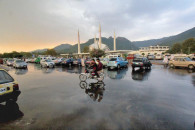Can AI predict next climate disaster in Pakistan?
These incidents of flooding were triggered by Glacial Lake Outburst Floods (GLOFs)

The recent flash floods in Khyber-Pakhtunkhwa have unleashed unprecedented destruction in many parts of the province. Karachi, the largest city of Pakistan, was also paralysed by the onset of heavy rains and urban flooding. Drainage lines were blocked, traffic systems collapsed and a large part of the city remained in the dark due to prolonged power outages. These events have added to the long list of climate-related disasters that have struck Pakistan in the year 2025.
Summers in Pakistan began with an intense and protracted heatwave with temperatures reaching as high as 52 degrees Celsius and a death toll of around 1,200. On the other hand, a freak hailstorm struck the twin cities of Islamabad and Rawalpindi in April. Hailstones, the size of tennis balls, severely damaged houses, cars and other critical infrastructure. The situation grew worse due to several episodes of flash and urban flooding that devastated multiple northern and urban centres.
These incidents of flooding were triggered by Glacial Lake Outburst Floods (GLOFs), cloudburst and torrential monsoon rain. According to National Disaster Management Authority (NDMA), nearly 800 people have lost their lives due to floods across Pakistan since June 2025. While emergency response mechanisms are put into action in the aftermath of such disasters, the solution does not lie in managing the catastrophes after they have struck but in preventing them through timely prediction.
Pakistan Meteorological Department (PMD) is the primary authority that issues warnings and advisories about possible climate-related events. PMD does, in fact, issue general advisories outlining not only the intensity of the rainfall but also the cities and districts that may be affected. However, these advisories lack hyperlocal precision, which is crucial for timely response to any natural disaster. A hyperlocal forecast would mean accurate prediction about a possible weather phenomenon that go beyond the level of cities and districts and focuses on real-time updates about sectors, zones, blocks, wards and union councils.
This is where emerging technologies, such as AI, play a key role. AI-based weather forecasting systems use a wide range of statistical data to accurately predict future weather patterns. Such systems could easily collect and process data from satellite imagery, weather stations, radars, traffic controls, drainage management authorities and Urban Internet of Things (IoTs) to accurately predict and warn about the next climate disaster before it strikes.
If implemented, an AI-based weather forecasting system would be cheaper than the traditional statistical forecasting models that Pakistan currently employs. By integrating data and inputs from PMD, NDMA, Water and Sanitation Authority (WASA), Rescue 1122 and district authorities, AI-based weather system could serve as a ward-level early warning architecture.
Google is already providing forecasting services in both India and Bangladesh using AI models under its Flood Forecasting Initiative. These systems use real time data to provide forecast up to 48 hours in advance and it covers around 360 million people across India and Bangladesh. In contrast, Pakistan is yet to leverage the emerging technologies to predict and prevent natural disasters with precision. Weather forecasting in Pakistan remains largely manual. Authorities in Pakistan continue to rely on conventional statistical and time taking models for weather forecasts.
The difference between normal and extraordinary weather conditions is eroding fast due to climate change. Freak weather phenomena are swiftly becoming a regular occurrence in Pakistan. Therefore, disaster prevention must precede management. To realise this vision, Pakistan needs to mandate integration of data between weather, health, drainage and municipal authorities.
Development and integration of AI-based forecasting systems is urgently needed. Public-private partnership could play a critical role in development of such systems. AI start-ups and research centres with a capacity of training locally-driven models for weather forecast must be supported. Without these actions, the response of the country would remain limited to just the management of a disaster in its aftermath.












COMMENTS
Comments are moderated and generally will be posted if they are on-topic and not abusive.
For more information, please see our Comments FAQ